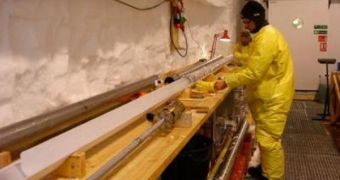Understanding the effects that global warming will have on our planet is very difficult to do without looking at the past. This is precisely the goal of an international collaboration, featuring Danish and American investigators. The group has been working on th North Greenland Eemian Ice Drilling project for more than 24 months, and their work is finally beginning to pay off. On July 27, the digging tools the team uses reached bedrock, more than 1.5 miles beneath the ice sheet.
Core and rock samples collected by this investigation will provide a very clear picture of how the climate of the planet looked like during the Eemian interglacial period. This time frame stretched between 130,000 and 115,000 years ago, and saw Earth experiencing temperatures that were 3.6 to 5.4 degrees Fahrenheit above the average ones we register today. The experts hope that detailed analysis of the past would be able to provide them with additional clues on how Earth will react when it gets significantly warmer.
“Scientists from 14 countries have come together in a common effort to provide the science our leaders and policy makers need to plan for our collective future. I hope that NEEM is a foretaste of the kind of cooperation we need for the future, because we all share the world,” says ice core expert Jim White. The scientist is the lead U.S. investigator on the project, and he is based at the University of Colorado in Boulder (UCB). He explains that sea levels during the Eemian time were up to 15 feet (4.5 meter) higher than they are today, ScienceDaily reports.
“We expect that our findings will increase our knowledge on the future climate system and increase our ability to predict the speed and final height of sea level rise during the Eemian,” explains professor Dorthe Dahl-Jensen, who is the director of the Centre of Ice and Climate at the University of Copenhagen. She reveals that the underground samples the NEEM initiative is just starting to reach could allow geologists a clear view into understanding past precipitation and wind patterns, as well as finding out which plants lived at what time. This may help investigator paint a clearer picture of how Earth looked like at the time.

 14 DAY TRIAL //
14 DAY TRIAL //